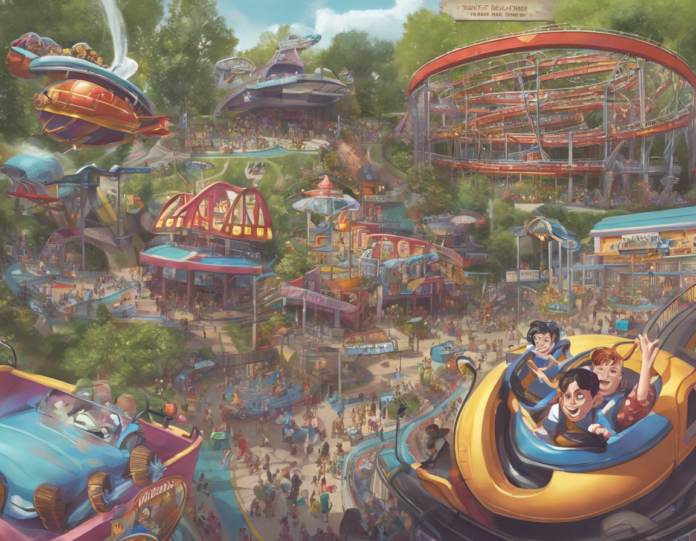Welcome aboard the thrilling roller coaster ride at the heart of every theme park. The rush of adrenaline, the wind in your hair, and the twists and turns that make your heart race - these are the hallmarks of a classic amusement park attraction. For many, the roller coaster is the epitome of theme park fun, offering a perfect blend of excitement, speed, and thrills. Whether you're a first-time rider or a seasoned coaster enthusiast, there's something undeniably captivating about the experience of hurtling through the air at high speeds, screaming in delight or terror.
The History of Roller Coasters
To truly appreciate the modern roller coaster, it's essential to understand its rich history. The concept of roller coasters can be traced back to 16th-century Russia, where ice slides were constructed for sledding during the winter months. These early designs laid the foundation for the gravity-driven thrill rides we know today. However, the real breakthrough came in 1884 with the construction of the first modern roller coaster at Coney Island in New York. Known as the Switchback Railway, this wooden coaster set the stage for a golden age of amusement park innovation.
Types of Roller Coasters
Today, roller coasters come in all shapes and sizes, offering a wide range of experiences for riders of all ages. From traditional wooden coasters to state-of-the-art steel behemoths, there's a roller coaster out there for everyone. Some common types of roller coasters include:
-
Traditional Wood Coasters: These classic coasters are known for their rickety charm and nostalgic appeal. With iconic features like drops, curves, and bunny hops, wooden coasters provide a rougher but no less thrilling ride.
-
Steel Coasters: Steel coasters have revolutionized the amusement park industry with their smooth, customizable designs. These coasters can feature inversions, launches, and high-speed maneuvers that push the boundaries of what's possible.
-
Inverted Coasters: Inverted coasters suspend riders beneath the track, creating a unique sensation of flying through the air. These coasters often feature intense loops, corkscrews, and twists that keep riders on the edge of their seats.
-
Launch Coasters: Launch coasters use powerful propulsion systems to catapult riders to top speeds in a matter of seconds. These coasters are known for their intense acceleration and heart-pounding thrills.
The Psychology of Roller Coasters
What is it about roller coasters that makes them so appealing to thrill-seekers? The answer lies in the complex interplay of psychology and physiology that occurs during a coaster ride. Roller coasters provide a controlled environment in which riders can experience fear, excitement, and exhilaration in a safe setting. The physical sensations of speed, acceleration, and G-forces trigger the release of adrenaline and endorphins in the brain, leading to a natural high that many find addictive.
Safety and Maintenance
While roller coasters are designed for thrills, safety is always the top priority for amusement park operators. Modern coasters undergo rigorous testing and inspections to ensure they meet strict safety standards. From redundant safety systems to regular maintenance checks, every precaution is taken to keep riders safe while enjoying the ride of a lifetime.
Frequently Asked Questions (FAQs)
-
Are roller coasters safe?
Roller coasters are statistically one of the safest forms of entertainment, with stringent safety measures in place to protect riders. -
What should I do if I'm afraid of roller coasters?
If you're anxious about riding a roller coaster, start with a milder coaster and work your way up to more intense rides at your own pace. -
Can roller coasters make you sick?
Motion sickness can be a concern for some riders, so it's essential to stay hydrated and take breaks between rides if you start feeling unwell. -
What is the tallest roller coaster in the world?
As of now, the tallest roller coaster is the Kingda Ka at Six Flags Great Adventure in New Jersey, standing at a towering height of 456 feet. -
How fast can roller coasters go?
Roller coasters can reach speeds of up to 150 miles per hour, offering a pulse-pounding experience for adrenaline junkies. -
What should I do during a roller coaster ride?
To enhance your experience, try raising your hands, screaming, and letting go of any fear - immerse yourself fully in the thrill of the ride. -
Are there age or height restrictions for riding roller coasters?
Most roller coasters have height restrictions to ensure the safety of riders, and some coasters may have age restrictions as well. -
How are roller coasters designed and engineered?
Roller coasters are meticulously designed using computer simulations and engineering principles to create thrilling but safe experiences for riders. -
What should I wear when riding a roller coaster?
It's best to wear secure, comfortable clothing and remove any loose items such as hats or glasses before boarding a roller coaster. -
Is it safe to ride roller coasters while pregnant?
Pregnant women are generally advised against riding roller coasters due to the potential risks of sudden accelerations and G-forces.
In conclusion, the roller coaster remains a timeless symbol of fun and excitement at theme parks around the world. From its humble origins as a wooden thrill ride to the cutting-edge steel coasters of today, the evolution of roller coasters mirrors our ongoing quest for bigger, faster, and more thrilling experiences. So strap in, hold on tight, and get ready for the ride of a lifetime - the roller coaster awaits!

